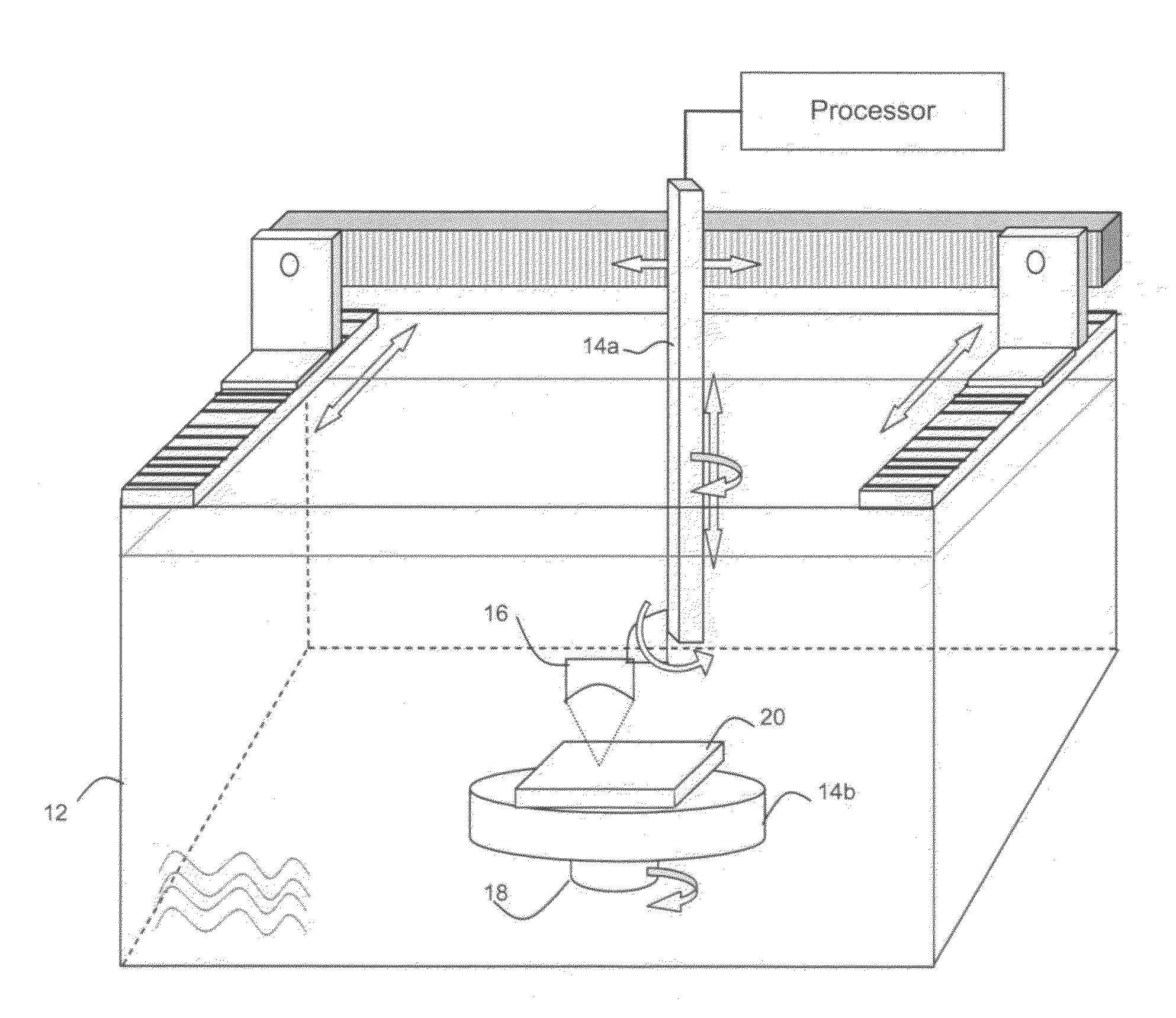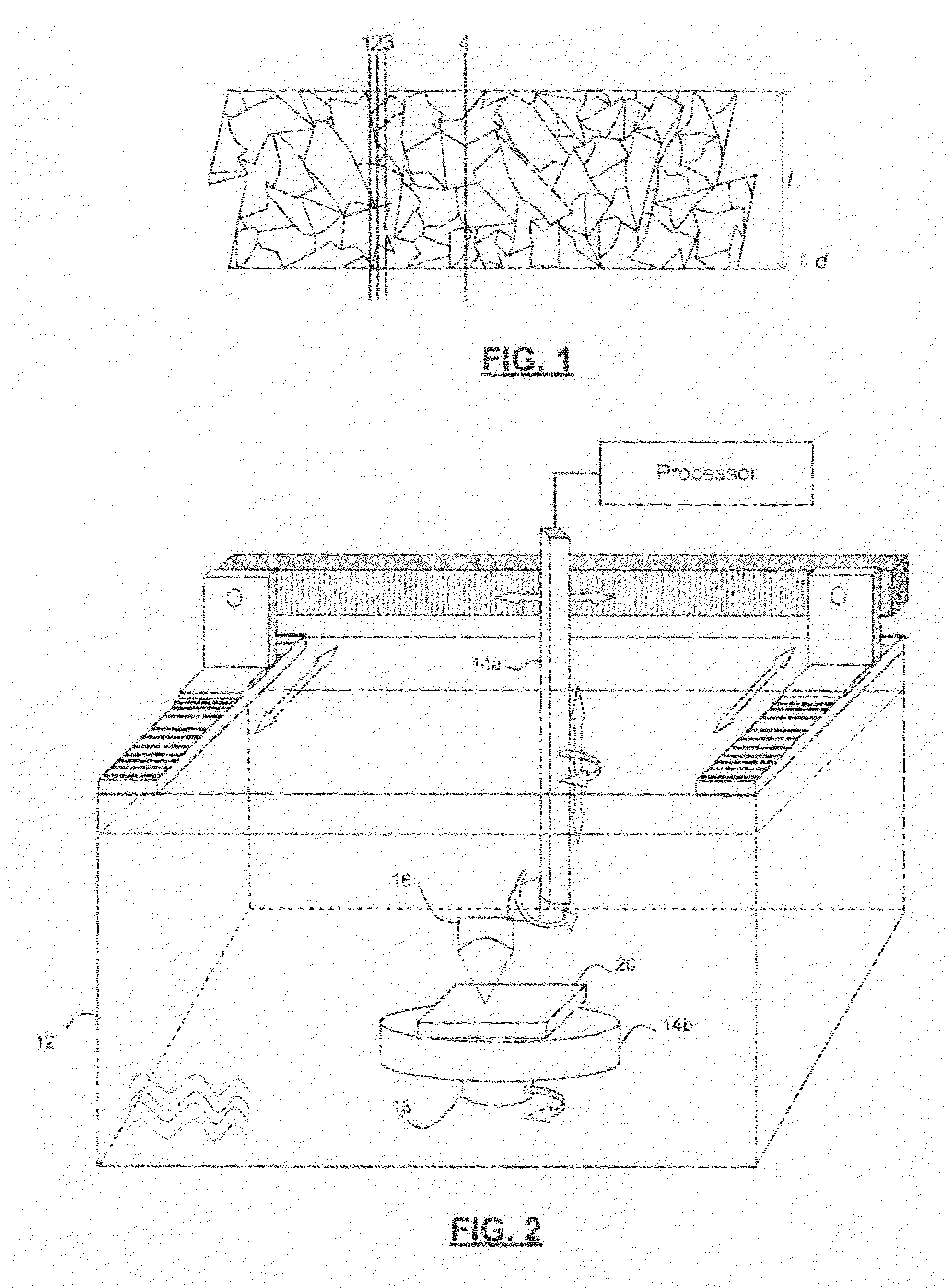Method and apparatus for ultrasonic characterization of scale-dependent bulk material heterogeneities
a bulk material and ultrasonic technology, applied in the field of characterization of scale-dependent uniform bulk material heterogeneities, can solve the problems of difficult detection and characterization of heterogeneities, heterogeneities consisting, and difficult detection of subtle chemical variations or phase segregation
- Summary
- Abstract
- Description
- Claims
- Application Information
AI Technical Summary
Benefits of technology
Problems solved by technology
Method used
Image
Examples
example 1
Macrozone Characterization
[0112]An apparatus according to FIG. 2 was used to demonstrate the present invention. Specifically, a 10 MHz transducer of half-inch (12.7 mm) diameter, d, with a focal length, f, of 1.25 inch (32 mm) was used (i.e. F / 2.5). In titanium alloys, the acoustic wavelength of 10 MHz ultrasound is approximately λ=0.6 mm. Therefore, we expect to be able to measure heterogeneities having a dimension in the imaging plane that is larger than several tenths of a millimeter. In water, the acoustic wavelength at 10 MHz is approximately 0.15 mm. For the transducer specified above, the spot size at the focal point (beam diameter at half maximum amplitude), BD, is given by:
BD=0.51λtanθ0=0.51fλd
and is equal to 0.19 mm. Therefore, this too should allow the measurement of material heterogeneities of dimensions equal to or larger than a few tenths of a millimeter.
[0113]The transducer is positioned directly above the part, which is a titanium plate. The plate was positioned with...
example 2
Surface Macrozone Characterization
[0133]FIG. 13 is an image of the surface of the titanium plate obtained by polishing and macroetching to reveal macrozones (a term for LRVEs in titanium alloys). The image has a 6×6 cm2 area. Macroetching involves pickling the surface in acid until etching reveals macroscopic patterns. In this case, macroetching is used to display the macrozones, also called “forging fibres” or “flow lines”. In near-alpha titanium alloys, the etched surface is dull and displays a macrostructure revealed by alternating regions of various grey densities. These grey regions are parallel in billets and they show the material flow in forged parts.
[0134]Two methods were employed to measure the dimensions of the macrozones. In the first method, we define a macrozone as a surface area of uniform grey level. For a start, the mean linear intercept method used to measure the size of grains was employed to measure the width of these macrozone, a method similar to the ASTM E112-...
example 3
Narrow Path Requirement
[0137]To illustrate the importance of measuring only ultrasound confined to a path that is narrower than the characterized LRVEs, we now compare our measurements with those of Reference [ii]. FIG. 14 is extracted from the Reference [ii]. In this reference, a 5 MHz transducer with F / D ratio of 8 was focused on the distal side of a 1.3 inch thick (33 mm) plate sample in a manner shown schematically in FIG. 3. At the focal point of such a transducer, the beam diameter, is 2.4 mm. At the proximal surface, the diameter of the ultrasound source 22 is 16.4 mm, at least one order of magnitude greater than the dimensions of the LRVEs shown in the photograph. FIG. 14 (left image) shows irregular shapes of patches of different amplitudes, the patches having widths (vertical dimension) on the order of 1 mm or less. Therefore, the experimental arrangement does not allow to define a ray or a path of lateral dimension smaller than the width of the macrozone (or LRVE).
[0138]T...
PUM
 Login to View More
Login to View More Abstract
Description
Claims
Application Information
 Login to View More
Login to View More - R&D
- Intellectual Property
- Life Sciences
- Materials
- Tech Scout
- Unparalleled Data Quality
- Higher Quality Content
- 60% Fewer Hallucinations
Browse by: Latest US Patents, China's latest patents, Technical Efficacy Thesaurus, Application Domain, Technology Topic, Popular Technical Reports.
© 2025 PatSnap. All rights reserved.Legal|Privacy policy|Modern Slavery Act Transparency Statement|Sitemap|About US| Contact US: help@patsnap.com



